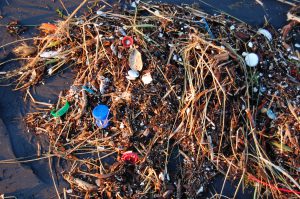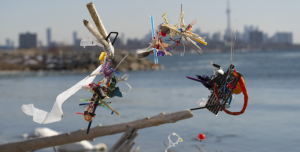
Environment
Bioplastics: Don’t let the label fool you
Doing your part as an eco-conscious consumer doesn’t end once you buy a bioplastic product
- 1626 words
- 7 minutes
Mapping

Heading out grocery shopping, put on a mask. Going for a walk in the park, put on a mask. The use of personal protective equipment has skyrocketed as people around the world work to control the spread of the COVID-19 virus. The health sector, businesses and the public are using more disposable plastic masks, gloves, face shields, gowns and disinfectant wipes than ever before.
A large portion of PPE waste is disposed of through the regular garbage system or simply tossed aside – left on the ground as litter in parks and on sidewalks. This has sparked a complex global plastic crisis.
A November 2020 report by Tony Walker, an associate professor at the School for Resource and Environmental Studies at Dalhousie University, an estimated 129 billion face masks and 65 billion gloves are used globally every month. That’s three million masks a minute.
Shoshanah Jacobs, an associate professor in the department of integrative biology at the University of Guelph, says PPE plastics are quickly becoming as familiar as plastic bags or straws. “One of the sad challenges of this story is that we really should have anticipated the waste problem and come up with management plans in order to be able to encourage the public to be able to dispose of it,” she says. “It’s such a big problem. Certainly, we could start having conversations and maybe start implementing programs, and yet, I still haven’t seen any of [that]. I’m torn because I recognize that waste management may not be one of our big priorities right now, and yet, surely there are people that could have supported this effort from the beginning.”
Jacobs has observed PPE in parking lots, around garbage cans and even on her front lawn. She says it’s important to account for that initial gut reaction of ‘Oh, I don’t want to touch that’ when approaching PPE debris. When face masks first found their way to her lawn, she was hesitant to touch them, asking herself questions like – ‘Can I collect this safely?’ or ‘Do I leave it there for three days?’ She says she learned that as long as she had a barrier in between her and the product and popped it into the bin, it was just fine. Some of these barrier tools could include reusable gloves, a litter grabber claw or a shovel.
Used PPE tends to end up littering parks, bus stops and parking lots. “We have to dig into why PPE is ending up right at the bus stop or right on the parking lot ground in order to be able to design a program that will ensure that it does get into the right waste stream,” she says. “I think, clearly, there’s a priority to human health, but that has been taking over a lot of our environmentally conscious behaviors.”
There is minimal research about the quantities of PPE waste produced since the beginning of the COVID-19 pandemic, but scientists have begun doing surveys and making predictions.
When the pandemic began in March 2020, Justine Ammendolia, an environmental scientist and data analyst, and her partner Jacquelyn Saturno observed masks, gloves and disinfectant wipes piling up in day-to-day places throughout their long daily walks around Toronto.
“The problem is there’s just too many facets of society using these types of items and it’s hard to get those numbers together,” Ammendolia says. “How do you measure? How do you know what’s coming into the system and what’s going out?”
The accelerating widespread production, consumption, and disposal of PPE makes it complicated to pinpoint these answers, but last May Ammendolia and Saturno decided to do something.
They surveyed six different locations using the Marine Debris Tracker, a geospatial citizen-science tool created by the University of Georgia New Materials Institute. Over the course of five weeks, they reviewed residential areas, commercial grocery store parking lots, a recreational trail, and a hospital district to gather their data samples.
This study allowed them to get a pulse on where pollution was coming from and what times they saw increases in PPE to gain a better overall understanding. The hotspots included residential areas, parking lots and hospitals. A total of 1,306 debris items were found – single-use gloves made up 44 per cent of the debris, followed by face masks (31 per cent) and wipes (25 per cent).
Medical centres follow disposal management methods like sterilization and incineration. Single-use PPE items were recommended for these sectors but not specifically encouraged for the general public who don’t have a waste management infrastructure in place. The waste generated by the public is a new phenomenon as outlined in Ammendolia’s research paper.
“As we deal with plastic pollution, it’s good to know that there are points to improve and there’s a lot of work that we can do to prevent this from happening in the future and becoming a big problem,” Ammendolia says. “Asking politicians to pay attention is always a good start and getting media attention is great – but then, on an individual level, there’s so many things you can do.”
We need to implement structures to deal with this waste. Ammendolia recommends having targeted campaigns where supermarkets – that often supply wipes and masks – are encouraged to increase waste disposal. Creating educational pieces to transfer these important messages about PPE disposal is a step in the right direction.
She says it’s important to work towards eliminating disinfectant wipes, plastic gloves and masks from your plastic diet to help mitigate the impacts of your plastic on the environment. One effort is to use reusable masks as you’re producing less waste and they’re easy to decontaminate through washing.
For anyone who’s a non-essential worker going to the supermarket, there’s no need to use plastic gloves or plastic disinfectant wipes according to Ammendolia. She says hand washing is key to prevent against contracting the disease and is what every major health agency recommends.
There have been reports of people misdirecting their waste through recycling or flushing it down the toilet. Just as there are now separate spaces to dispose of cigarettes, Jacobs says it could be efficient to have a separate bins for people to dispose of PPE.
A number of municipalities across Canada have asked that people tightly secure their waste in a separate bag before placing it in the garbage. Animals not only have the ability to retrieve PPE from an open face garbage, but it also has the potential to blow out.
“Just as we wouldn’t want it flying around in our own house – we wouldn’t want that in the environment either,” says Ammendolia.
Jacobs predicts wildlife will be incorporating PPE plastics into their nests and some will probably confuse discarded PPE for food sources. There have been numerous sightings of wildlife becoming entangled and trapped in PPE waste. A few months into the pandemic, a dead penguin was spotted washed up on Juqueí beach in São Paulo, Brazil; it had a mask in its stomach.
Aside from entanglement and ingestion, Ammendolia says they’re starting to find animals are also impacted by the chemicals leaching off these plastics into soil and water. When plastic is left for a prolonged period of time it will eventually break down and create microplastics. When you have millions of these microfibers, it’s quite challenging to remove from the environment. They’re expecting to see a detectable amount of microplastic pollution created from PPE waste.
“As they break down over the coming years, we’ll see this sort of increase in microplastic pollution within wildlife tissues and digestive systems,” Jacobs says. “I imagine that it will be similar to what we’ve documented before, but just in a greater [number] of observations or concentrations.”
Jacobs says over decades, plastic pollution will reach uninhabited environments just as it gets distributed now through our ocean systems.
“Once we start talking [about] water bodies, that’s when it gets more complicated because you drop it in your river, [it] goes down the river, hits a lake [and] eventually makes its way down to the ocean,” Ammendolia says. “You have a type of plastic that’s really equipped to travel far.”
Already, eight to 12 million metric tonnes of plastics enter our oceans annually according to OceansAsia, a marine conservation organization. A 2020 report by the organization estimated between 4,680 and 6,240 tonnes of PPE plastic likely entered the oceans last year.
It was reported only a month into the pandemic that PPE had already made its way to some of the world’s most remote beaches. OceansAsia reported finding face masks on Hong Kong’s Soko Islands.
“It’s reasonable to predict that there would be a detectable increase or pulse like event of global pollution,” Jacobs says, comparing the pollution extent to a global volcanic eruption – affecting everyone around the world.
Are you passionate about Canadian geography?
You can support Canadian Geographic in 3 ways:

Environment
Doing your part as an eco-conscious consumer doesn’t end once you buy a bioplastic product

Environment
Fast food chains, municipalities and even Ikea have recently pledged to phase out single-use plastics

Environment
All the plastic that has ever been produced is part of the carbon cycle

Environment
Five new works commissioned by Canadian Geographic offer eye-catching and compelling commentary on the impact of plastic on our planet